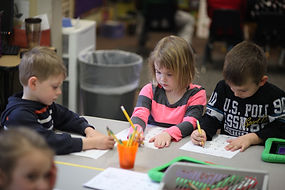

Preschool
Preschool learners, ages three through six years old, are offered a curriculum rich in experiences that develop their intellectual, language, motor, and social-emotional development. Children explore and are encouraged to learn through play activities including touching, seeing, hearing, and moving, as well as interacting with the environment and each other. Exposure to literature, art, music, math, science, and social studies in an age-appropriate manner helps foster curiosity and a love for learning. Predictable routines provide a framework for feeling safe and encourage children to build self-confidence and respect for others. Throughout the school, as well as in each classroom, teachers promote children’s interactions with each other to build a sense of community and belonging. Our learning environment supports the immersion of children in age-typical settings at the earliest suspicion of developmental, social, or language delays or Autism Spectrum Disorder. Small classrooms with one licensed teacher and two certified teacher assistants allow for plenty of individual attention and encouragement.
Preschoolers with ASD are immersed in our age-typical preschool classrooms and receive intense intervention that is systematically embedded within the normal routine and activities. Teachers provide the needed support to ensure children’s success as they grow and learn beside their typically developing peers. Empirically-based strategies are used to target the core deficits of ASD and enhance the acquisition, maintenance, and generalization of skills in a variety of settings, including the child’s home. Supplemental home programming is recommended and is provided in collaboration with CCDE Therapies. Speech and occupational therapists work collaboratively with the classroom teacher and provide weekly consult in the classroom.
A daily schedule includes:
Play Centers
-Many learning opportunities are embedded throughout play time, such as dramatic play (ice cream shop, Doctor’s office, grocery store), fine motor (hands-on and active handwriting program, iPads, cutting and art activities), problem solving (cause/effect, self-regulation, resolving social conflicts with peers), social interaction, language development (retelling stories/events, answering questions on topic, following simple directions or requests), sensory development (sensory tables with rice, beans, snow, sensory bins with fine motor tasks like using tongs to pick up pompoms, etc.), and time management (following a play schedule, work/class routine, turn-taking, sharing, expressing feelings and showing confidence).
-Learning activities in literacy, math, science, and social studies are also embedded throughout play time. Our curriculum is aligned with the Ohio Department of Education early learning content standards.
Literacy Time
-Story time and book time promote awareness of books and print. Visits from a storyteller with the public library occur monthly as well.
-Literacy-based activities are woven throughout the daily classroom routine.
-The Letter People curriculum employs songs, puppets, and handwriting to encourage the development of pre-reading skills.
Motor and Movement
-Motor and movement are addressed many times throughout the day during music and dancing, playtime (building tracks and roads, playing musical instruments, animal yoga), and outside time (slides, climbing the playground equipment, bikes, etc.).
-Obstacle courses and outdoor playground equipment are utilized during gross motor times also.
-Precision Teaching is used in the format of the “Go Fast” game to improve and refine fine motor skills. All of our preschoolers love this game.
-The “Handwriting Without Tears” system is a fun and engaging way to help reinforce fine motor and pre-writing skills by playing, singing, and building letters.
Music
-Music is approached both formally and informally. Music is used for preparing children for transitions, exploring the alphabet, promoting movement and imitation, and encouraging language development.
-Formally, children explore rhythm, tone, and pitch with the help of our music teacher.
Art
-Art is a medium that encourages exploration, creativity, imagination, and sensory experiences. Learning concepts in reading, math, science, and social studies are creatively embedded in art activities.
Field Trips
-Field trips help our preschoolers explore their community as well as reinforce early learning content standards (apple/pumpkin picking, visits to the farm, etc.)
-Teaches social skills and following group directions.
Schedule
-Preschool classes operate five days per week during the school year.
-Preschoolers may attend full day or part time.
Summer Program
Fun activities and camps are planned throughout the summer months for our preschoolers including “Gym and Swim”, “Books, Cooks, and Crafts”, and many more.








